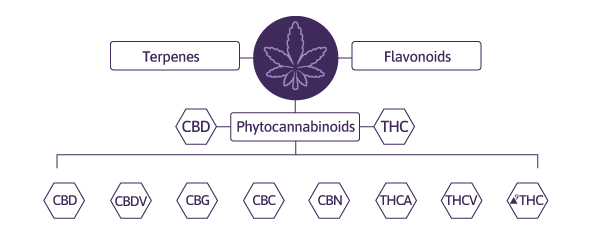The cannabis plant contains a complex mixture of physiologically active compounds, with hundreds of different cannabinoids, terpenes, and other compounds identified to date. The two primary categories of compounds found in cannabis are cannabinoids and terpenes, which contribute to the plant’s various effects and characteristics.
Here’s an overview of the main components:
- Cannabinoids: These are the most well-known and studied compounds in cannabis. They interact with the body’s endocannabinoid system, which plays a role in regulating various physiological processes. The two most abundant and well-known cannabinoids in cannabis are THC & CBD.
- Terpenes: Terpenes are aromatic compounds found in many plants, including cannabis. They contribute to the plant’s flavor and aroma and also have therapeutic effects. Some terpenes found in cannabis include myrcene (with a musky scent), limonene (with a citrus scent), and pinene (with a pine scent). Terpenes influence the overall effects of a particular cannabis strain.
- Flavonoids: Flavonoids are a group of phytonutrients found in cannabis and other plants. They have antioxidant and anti-inflammatory properties and may contribute to the plant’s overall therapeutic potential.
- Sterols: Phytosterols are a class of plant-derived sterols that are present in various plant species, including cannabis, and they serve several important biological functions in plants. One of the primary functions of phytosterols in plants is to help regulate the fluidity and permeability of cell membranes. β-sitosterol, campesterol, and stigmasterol are phytosterols that have been studied for their potential health benefits in humans when consumed as part of a balanced diet. They are known to have cholesterol-lowering properties and may contribute to heart health. While they are not typically the primary focus of cannabis research or use, they are part of the plant’s overall chemical composition and may have subtle effects or contribute to the entourage effect, where multiple compounds work together to produce the plant’s overall effects.
- Other compounds: Cannabis contains a wide range of other compounds, including fatty acids, proteins, and various minerals and vitamins.
The specific composition of these compounds can vary significantly among different cannabis strains, which is why different strains produce different effects. The cultivation and breeding of cannabis have allowed for the development of strains with varying cannabinoid and terpene profiles to cater to different preferences and therapeutic needs.
The synergy of these plant components working together to produce a combined effect that is greater than the sum of their individual effects is called the entourage effect. The entourage effect suggests that using whole-plant cannabis extracts or consuming cannabis in its natural form may provide a broader spectrum of therapeutic benefits compared to using isolated compounds. This has significant implications for the use of cannabis for both medical and recreational purposes, and underscores the importance of considering the whole-plant context when studying or using cannabis.
The Entourage Effect








